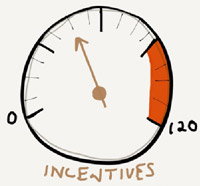
You can have all of the fancy bells and whistles, or go very low tech in how you are going to capture contributions from your participants, but if they are not stimulated properly, at best, they will show up once and leave, and at the worst, they will not show up at all.
Having been at this for a while now, we have created the Stimulation Map™, a set of drivers that need to be “tuned” to each activity and audience in order to have optimal stimulation and, ultimately best success for online collaborative engagement, consultation, or crowdsourcing initiative.
We know that figuring out which stimulant to turn up or down for each particular engagement can have a decisive impact on a community, and therefore on the results achieved. An overview of the six stimulants is outlined below.
Incentives
Incentives can play an important role in a crowdsourcing engagement. Sometimes money is the answer. Sometimes not. Often we have found that the best incentives are non-financial. Creativity, planning and sponsor commitment are the best attributes for good incentive stimulation. Doing that always and knowing when to double-down on incentive stimulation can have an impressive impact on your engagement.

Is the participant going to grow their community, engage with others they know, find people that stimulate them? Depending on the engagement, this is a big participation driver. For instance, if the focus on your innovation engagement is narrow and you are not expecting a massive amount of people, make sure that you let potential participants know that they will be able to find and connect with others that share their relatively unique interest. When do you turn this dial up and when do you turn it down…and how?

Where’s the meat? Does the individual have confidence that there will be outcomes and change through this exercise? Outcomes always matter but for certain engagements they are core to success. One example where you need to have and communicate clear outcomes for an innovation engagement is with an internal crowd where morale may be low.
Enjoyment

For certain engagements, there is no doubt that some fun can go a long way to enhance the quality and frequency of the dialogue. What should your fun quotient be? Are there engagements where “fun” should never be a stimulant? We’ve found that even in the most serious innovation engagements, keeping a perspective and looking for proper ways to ensure participant enjoyment are beneficial.

There has to be value in it for the individual participant. The better you are at establishing that and the more you have of it, the more inclined people are to participate. This stimulant needs to be omnipresent but the level and focus will change based on the engagement. For first time engagements with a new community, make sure you outline the value to them clearly (and make sure – to the best of your ability – that it happens).

Depending on the engagement, the convenience factor can be huge in dictating the success of your engagement. What are you doing to set the right level for your engagement? We have found that this stimulant has trended up noticeably even in the last year and particularly for any external innovation…people in any demographic simply have more choices than ever to occupy their time. Oh, and convenience goes far beyond having an intuitive platform (which are table stakes)…be prepared to have convenient processes and communication as well.
So what you have found in your innovation travels?
Is stimulation that important? Can stimulation and the emphasis and elements associated with a variety of stimulants ensure a successful innovation campaign or do you find other parts of an innovation solution are as or more important?
Are these the same stimulants that you have found? Does this cover the waterfront in terms of stimulation categories from your perspective?
What’s the proper stimulation “tuning” for your engagement? There is an infinite scope of innovation engagements, each – we would argue – with their own DNA. So what are some of your best practices for different styles of innovation engagement? Open, internal, small group and others.
By Geordie Adams
About the Author

Geordie Adams has been on the front lines of innovation for over 20 years, most recently through his founding of PubliVate, a leading partner in providing successful collaboration and innovation management solutions to organizations. If not working with public and private sector clients, Geordie can be found thinking (Canada), sharing (@publivate), and creating (www.publivate.com) around better ways in which people can work together.
